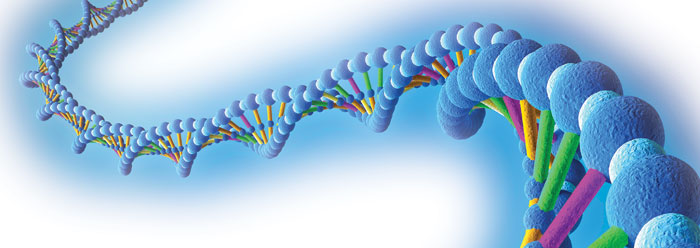In this series, we are tracing the Institute for Creation Research’s efforts to replace the evolutionary model on the origin of species with one that is both biblically faithful and scientifically superior. Previous installments give some background as to why we are pursuing this goal and to our progress.1,2 This update describes our successes involving the most controversial question of all: the from whom of species’ origins, or the question of species’ ancestry.
For over 150 years, Darwin’s answer to this question has troubled scientists and lay audiences alike. Nevertheless, his proposal that all species share a common genealogical thread—i.e., universal common ancestry—has become iconic as the familiar “tree of life” diagram. Surprisingly, despite this icon’s popularity, the evidence supporting it has never been scientifically compelling. For example, as we articulated in a previous article (part 5 in this series), the evolutionary arguments from the fossil record, from anatomical and physiological comparisons, and from biogeography are, at best, indirect.2 Genetics alone directly records genealogical relationships.
However, attempts to corral evidence of common ancestry from genetics have encountered significant challenges. In order to demonstrate the validity of a given hypothesis, scientific tests must eliminate competing hypotheses, and the tests of universal common ancestry have failed to do so. As a case in point, life is organized into a nested hierarchical pattern (groups-within-groups, analogous to Russian nesting dolls), a finding that evolutionists cite as confirmation of universal common ancestry. Yet intelligent humans design things that can be objectively organized into nested hierarchies. Hence, the mere existence of nested hierarchies cannot be used to support Darwin’s chief contention.3
Evolutionists have tried to eliminate the design hypothesis by other means, but to date their attempts have fallen short. To illustrate, secular scientists have long claimed that “junk DNA” exists, arguing that the apparent lack of design in large portions of human DNA refutes the idea of a creator. Yet recent experiments have revealed precious little evidence of such junk.4
Evolutionists have also tried to eliminate the design hypothesis via a different but related argument—the existence of shared mistakes. If two creatures share identical DNA copying errors, then the probability that those two species inherited these errors from a common ancestor, rather than both randomly making the mistakes independently, is quite high. In principle, this fact could connect humans and the great apes, along with all the other species on the planet. However, finding bona fide mistakes has been much more difficult than evolutionists originally thought.5 Thus, far from being the best-supported aspect of evolution, the question of common ancestry has been one of the most difficult to answer.
These difficulties carry over to the creationist approach, where there is a different ancestry question to solve. Since God created kinds of creatures in the beginning, and since these likely did not represent species but progenitors from which new species could arise, young-earth creationists face the challenge of identifying which species are related and which ones are not.6
The most promising lead on this question seems to be a discovery we made over a year ago: the existence of a molecular clock. At the DNA level, this clock has ticked off only 6,000−10,000 years of time, a fact that might be useful to the question of common versus separate ancestry.7 For example, if the molecular clock for two species can be dialed back to zero in just 6,000 years, then perhaps these two species have a common ancestor. If not, then they might stem from separately created kinds. As research progresses, we plan to detail how this clock might shed light on the origins discussion. Stay tuned!
Click here to read the previous articles in this series.
Click here to read Part 7.
References
- Jeanson, N. T. 2014. Purpose, Progress, and Promise, Part 1. Acts & Facts. 43 (10): 13; Jeanson, N. T. 2014. Purpose, Progress, and Promise, Part 2. Acts & Facts. 43 (11): 9.
- Jeanson, N. T. 2014. Purpose, Progress, and Promise, Part 3. Acts & Facts. 43 (12): 9; Jeanson, N. T. 2015. Purpose, Progress, and Promise, Part 4. Acts & Facts. 44 (1): 9; Jeanson, N. T. 2015. Purpose, Progress, and Promise, Part 5. Acts & Facts. 44 (2): 9.
- Jeanson, N. T. 2014. Darwin vs. Genetics: Surprises and Snags in the Science of Common Ancestry. Acts & Facts. 43 (9): 8-11.
- Jeanson, N. T. 2013. Does “Junk DNA” Exist? Acts & Facts. 42 (4): 20.
- Jeanson, N. T. 2011. Human-Chimp Genetic Similarity: Do Shared “Mistakes” Prove Common Ancestry? Acts & Facts. 40 (9): 6.
- Jeanson, N. T. 2013. The Origin of Species: Did Darwin Get it Right? In Creation Basics & Beyond: An In-depth Look at Science, Origins, and Evolution. Dallas, TX: Institute for Creation Research, 125-131.
- Jeanson, N. T. 2014. New Genetic-Clock Research Challenges Millions of Years. Acts & Facts. 43 (4): 5-8.
* Dr. Jeanson is Deputy Director for Life Sciences Research and received his Ph.D. in cell and developmental biology from Harvard University.




